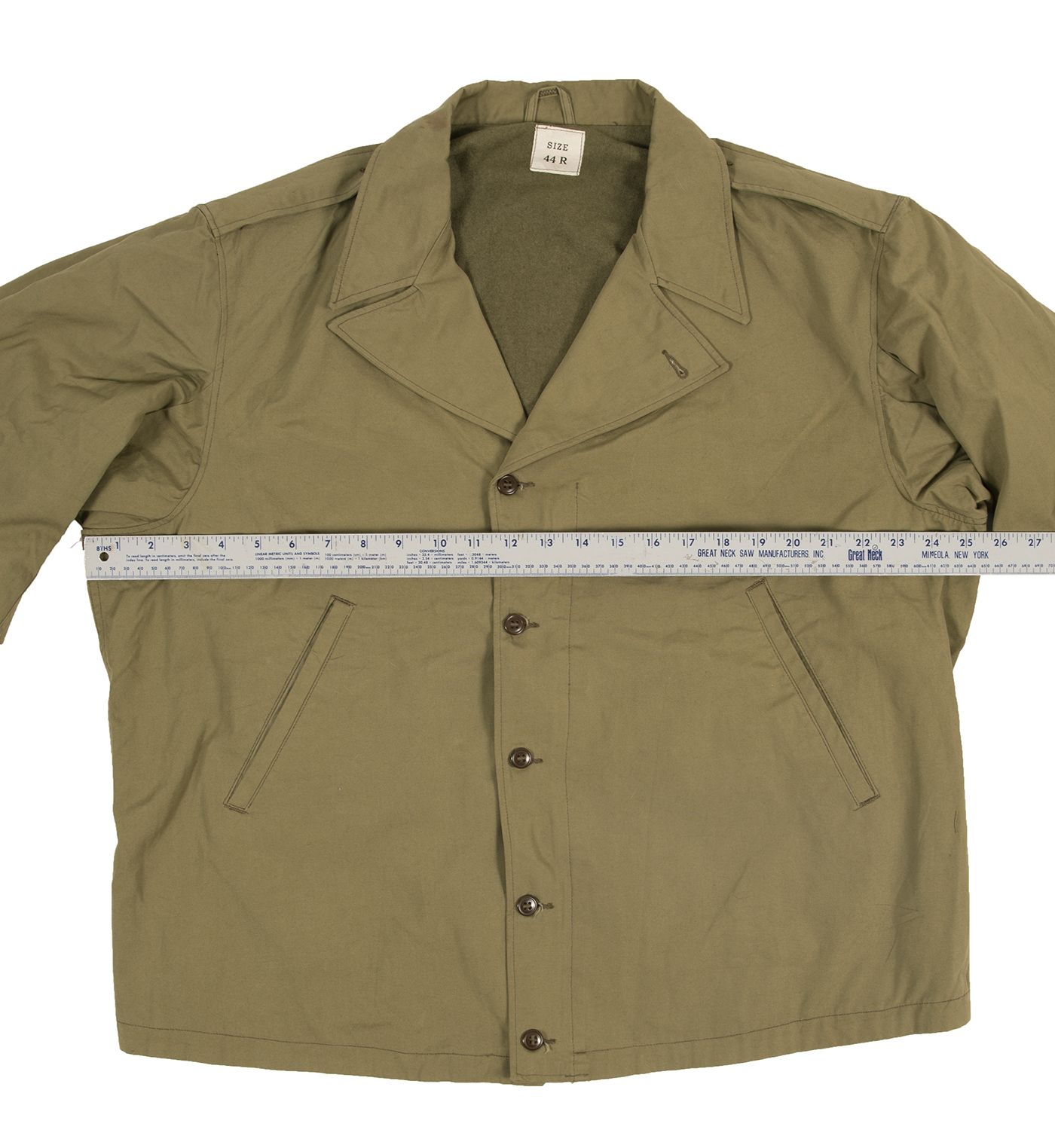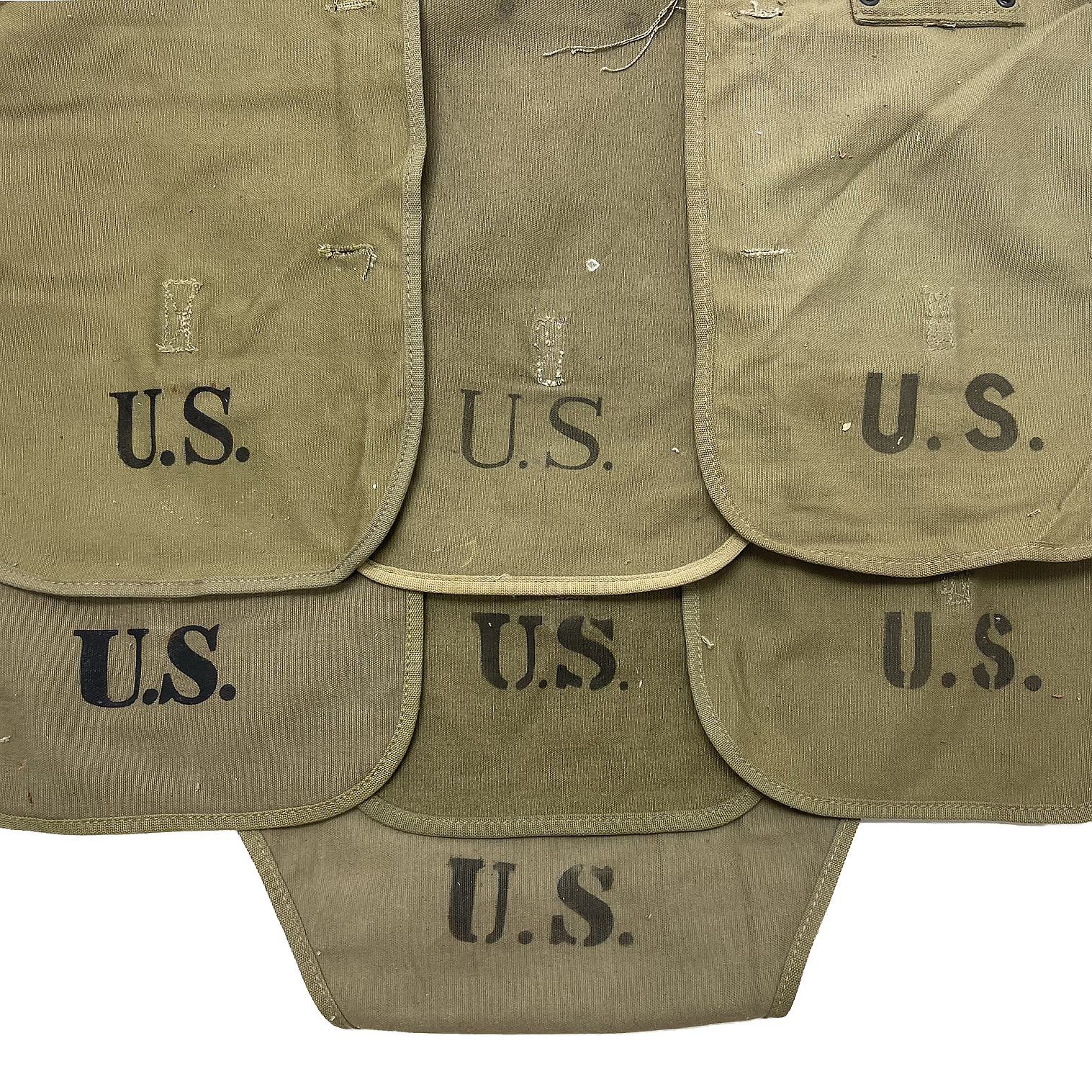XXL WWII Field Jacket! RARE!!! Measures 50″!!! One can look online, especially ebay, at any given time and find one or more vintage jackets listed with the actual chest measure advertised as the “size” by select sellers. I’m sure they’re not hoping to snag some unsuspecting person who will pay a premium price for what is actually a much smaller garment, who will be too embarrassed to return it- that is, if they even allow
The unexpected controversy over the “US” markings has been a total surprise to me. Even photos of piles of original gear, showing a wide range of variations of the markings, has simply prompted more questions. Why this year (2023) has seen a sudden fixation on them is a mystery. So, here are more photos as well as WWII documents to show and explain how and why they really were. The photo: These are some of our
Right click and open in new tab to see larger images.
From time to time we do get some fussing about marks, spots or other unwanted “blemishes”, typically on US fieldgear. This post is to show that many of these markings are necessary and intentional as they are part of the production process, not a flaw or error. Nearly all gear and garments are marked after they’re cut to show the workers exactly where to place pockets, make folds, straps, sew button and eyelet holes, or
This is the last installment on the ins and outs of the most expensive helmet decorations in the universe. Made from scraps: Over the years, I have read and heard much yammering about covers and caps being made from scraps left over from smock production, attempting to explain the tendency for the use of parts in multiple shades and patterns on most Waffen-SS camo items. There are two reasons this is not likely nor even feasible.
The reasons the Allies won WWII have been debated and bandied about for decades and always will be. There are obvious factors, and the not so obvious ones. Ever since I began making reproductions in the late 1980’s, this one has always stood out. Many enthusiasts are unaware that the Germans stitched much of their equipment by hand, even in 1944-45 when every minute of production time counted. The reasons are not entirely clear, but
As many readers are aware, the field of German WWII camouflage is overpopulated with countless experts (Wizards) who pump out facts on social media with little or no experience with originals much less actually making this stuff. One of the oldest fairy tales is that caps and helmet covers were made from scraps and leftovers from cutting smocks and shelter quarters. This is highly unlikely, to the point I’m comfortable putting it in the total
The two original covers used for our patterns. German camouflage is one of the most popular categories of militaria both in the collector market as well as among reenactors/ living historians. With originals being some of the most expensive clothing in the universe, knowing what’s what can potentially mean thousands of dollars made or squandered for those attempting to hoard it. It also means that many people don’t have access to the authentic examples aside
About Originals To date, we have never acquired the original Ordnance specifications for the M1907 or BAR slings. Likewise, there is scant information online or in the numerous books on US military rifles. The best description I’ve found, albeit one paragraph, is in Joe Poyer’s book on the M1903 Springfield rifles. So, all information posted here was gleaned from poring over originals in order to copy them as closely as possible. The M1907 Sling was
All information here is published in How to Shoot the U.S. Army Rifle; the Infantry Journal, pp 36-pp41 (Cover photo above) link here How to adjust the loop sling We are now ready for the second step- correct positions. You won’t hit the bull’s-eye every time unless you are steady. Three things control your steadiness. The Gun Sling Your Breathing Your Position The gun sling supports your arm and rifle. lt binds the rifle to
The skirt on a properly patterned Feldbluse does not fly up when one raises their arm(s) to aim, salute, climb or fasten the rear clip on their helmet cover. (Texled tunic shown.) In past weeks, we have received a large number of questions regarding German tunics. Most seem to have been prompted by expert commentary posted on Mark’s alternate universe. What are “Suitcoat Shoulders”? This is the name given some years ago to the tendency for
Original US uniforms in new or nearly new condition with the US Army’s terms for each color. L to R: Summer Service Shirt, M41 Jacket, Tanker Jacket, M1943 Field Jacket Khaki Fever Although the pestilence seems to have mutated into somewhat less virulent strains in recent years, it remains endemic to the hobby of WWII (and WWI) collecting/ reenacting. Precisely how and why it took hold decades ago is unknown- various theories exist but none can be
Some (or many) may shake their heads at some of these posts. Do people really care about tunic pocket angles and smock sleeve diameters? Yes, there is a pretty diehard group of uniform enthusiasts who get amped up over such things. Is this only in regard to German militaria? Not really. There are niches like this in the world of GI stuff as well. German camouflage is extremely popular and much of the information regarding
Signal Corps Photo Sizes Then & Now There is a cohort of history maniacs who periodically bleat that we should follow the WWII sizing tariffs to the letter- make the same ratio of each size uniform as was done in the 1940’s. Then their time warp will finally be correct! These guys may be intelligent and capable in other disciplines, but when it comes to selling clothing they’d be bankrupt within 30 days. Why?
“Plane Tree” CamouflageAll items pictured on this page are original, WWII production except the tree and the SPW (it’s partially original). During WWII, the German military developed, produced and utilized well over a dozen unique camouflage designs for their troops. The majority of these designs were created and worn by the SS formations. Today, authentic wartime examples are some of the most popular and expensive pieces in the military (and camouflage) collecting world. The
During my junior year of high school, in 1984, we did an exchange with a Kreisgymnasium in Germany. Their students came to us during the school year for several weeks, and that June was my first trip overseas. My exchange student, we’ll call him Andreas, had already visited us and I nearly cancelled my trip as I really didn’t want to deal with him again. If one looked up “creepy” in the dictionary, they’d find his photo-
Jacket, Field, Pile, O.D.The M1943 Field Uniform, which, with gradual updates, remained in production for the US military for over 40 years, had a rather controversial and tortuous birth. Despite apparent utility of the design, numerous high ranking officers attempted to stop or sabotage production repeatedly due to differing personal preferences, mostly regarding “soldierly appearances”. One of the most embattled components of the new layered uniform was the liner. After months of testing, a pile
Pfc. Floyd L. Rogers, 2nd Infantry Division, silver star, November 29, 1919 – July 12, 1944 About WWII Army HBT UniformsThis page consists of my observations and analysis of authentic WWII garments with some input from Risch and Pitkin’s QMC Historical Studies, Clothing the Soldier of WWII.With over 25 years experience manufacturing reproduction garments, I hope to be able to offer some insights not usually found in typical references. Despite this being one of the
The jackboot and M35/40 helmet are the most symbolic and frequently shown items of the WWII German soldier. More than any other image, that of the black leather jackboot has been used to represent the conquest of Europe by the Third Reich. As with my other posts, this will detail my cumulative observations over 30 years of handling, collecting, repairing and reproducing authentic WWII examples. Period documentation is scant, making this the best means of
31 December, 2018 The M1943 Field Jacket was the main component of the the US Army’s improved combat uniform issued in the latter part of the Second World War. This jacket, with only minor design changes, was issued to American troops for the next 50 years, and is still manufactured today for the civilian market. The United States entered WWII with her troops wearing “Parson’s jackets” (M1941’s) and wool serge trousers as their field/ combat
Late in 1942, the Germans introduced a new field cap. The caps were made from the same camouflage and fabric as their smocks and helmet covers, and were likewise reversible from Fall to Spring colors. Early production caps were fitted insignia, color coordinated to the appropriate sides of the fabric. This feature was dropped quickly and the vast majority of these hats were produced devoid of insignia. Caps were manufactured with and without air vents,
Many people do not realize that trousers from the 1940’s were cut differently than those made today. They tended to have higher waists, fuller thighs and very unflattering seats. The wartime pants designed for the US Army took these traits to new highs. Note: This information also applies to the Summer Service Trousers (commonly known as “Khakis”.) They are the same pattern as the wool serge trousers. The standard issue wool serge trousers were made
Welcome to the At the Front Blog. Despite over 20 years of being on the internet, this is our first official “blog”. Personally, I rarely read anyone else’s blogs, and have procrastinated about setting this thing up for several years. So here we go… The topics will generally be related to WWII uniforms & gear, WWII reenacting, plus a few random, unrelated things that strike me as worthy of writing about at a given moment.
More to come…

